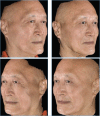Pan-Asian Consensus on Calcium Hydroxyapatite for Skin Biostimulation, Contouring, and Combination Treatments
- PMID: 34840663
- PMCID: PMC8570653
Pan-Asian Consensus on Calcium Hydroxyapatite for Skin Biostimulation, Contouring, and Combination Treatments
Abstract
Background: Several usage guidelines for calcium hydroxylapatite (CaHA), a dermal filler material, exist for non-Asian patients, making it necessary to determine whether their findings and consensuses are applicable to Asian patients who have distinct anatomies, cultural preferences, and aesthetic requests.
Objective: We sought to develop a Pan-Asian consensus on CaHA use in skin biostimulation, contouring, and combination treatments for face and body indications.
Methods: A survey on CaHA usage for contouring and biostimulation indications in Asian patients was conducted, followed by discussions to establish consensus statements and topics for examination.
Results: Several aspects of facial shaping and contouring or skin biostimulation with CaHA were agreed on, including that dilution is not a key consideration, that microfocused ultrasound with visualisation precedes CaHA in same day or session treatments, and that cannulas should be used. Among the many agreements on interventions in specific facial and body areas, there were also disagreements due to the diverse Asian patient presentations, requests, and access to tools or products; for example, CaHA should be placed in the interfascial layer for temple contouring, CaHA should not be injected directly into the infraorbital area for safety, and diluted CaHA should be injected subdermally for nonfacial or whole-face biostimulation and contouring.
Conclusion: Our disagreements highlight the diversity of Asian facial morphotypes and desired aesthetic outcomes and underscore the need for customized aesthetic strategies to accommodate the heterogeneity of Asian anatomies, cultural preferences, and aesthetic ideals. Establishing consensus statements on critical aspects of Asian patient considerations, efficacy and safety, is crucial. This document provides strategic guidance on the use of classic, diluted CaHA for biostimulation or undiluted Radiesse®(+) (Merz Pharma GmbH & Co. KGaA, Frankfurt, Germany) for lifting and contouring to ensure consistent CaHA delivery for successful patient outcomes.
Keywords: Asian; calcium hydroxylapatite; consensus statement; dermal fillers.
Copyright © 2021. Matrix Medical Communications. All rights reserved.
Conflict of interest statement
DISCLOSURES: All authors received an honorarioum for attendance at the consensus meeting.
Figures






References
-
- American Society of Plastic Surgeons.; Available at: 2018 Plastic Surgery Statistics Report. https://www.plasticsurgery.org/documents/News/Statistics/2018/plastic-su... Published 2019. Accessed March 6, 2020.
-
- Schachter D, Bertucci V, Solish N. Calcium hydroxylapatite with integral lidocaine provides improved pain control for the correction of nasolabial folds. J Drugs Dermatol. 2016 Aug 1;15(8):1005–1010. - PubMed
-
- Ahn MS. Calcium hydroxylapatite: Radiesse. Facial Plast Surg Clin North Am. 2007;15(1):85–90. - PubMed
Publication types
LinkOut - more resources
Full Text Sources
